Workplace Lighting Standards For Offices: A Complete Guide May 23, 2023 – Posted in: General Info, Lighting Information, Office Lighting
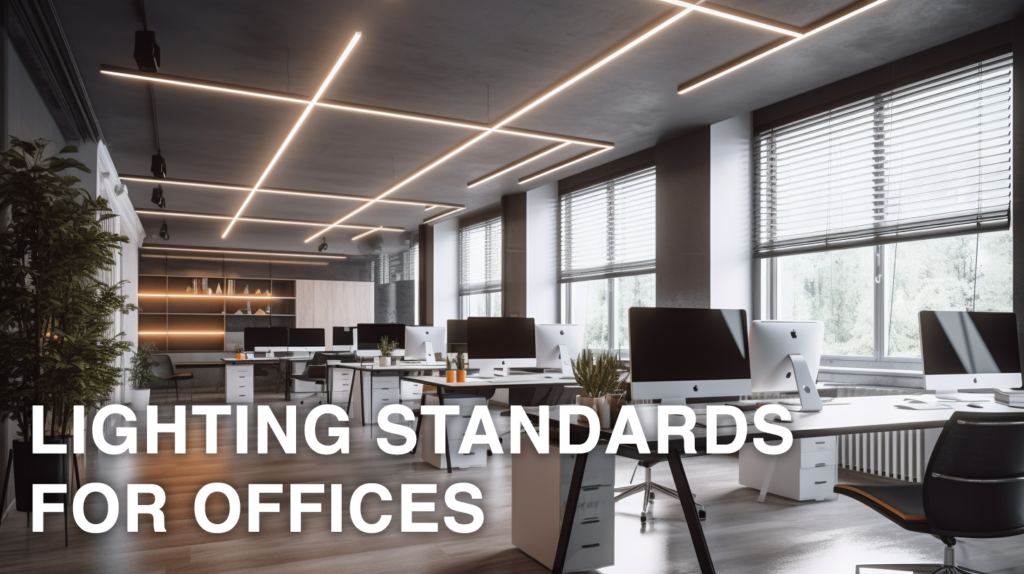
Table of Contents
Maintaining a safe, healthy, and productive working environment is important for any business, and part of that means ensuring that workspaces such as offices are properly illuminated. Although lighting is often taken for granted, it is something that it’s important to be aware of and there are state and federal guidelines and regulations specifically covering how to appropriately illuminate office spaces.
What Are Lighting Standards?
Lighting standards for offices are set by the Occupational Safety and Health Administration (OSHA) at a federal level, with some additional clarification added by the individual states. Typically the guidance makes reference to recommendations from the American National Standards Institute (ANSI), in particular The American National Standard Practice for Office Lighting, and The Illumination Engineering Society of North America (IESNA).
These office lighting standards set recommendations for the level of illumination in lux which vary with the type of work undertaken and whether it is primarily computer-based, as well as other, more general recommendations.
These focus on ensuring that employees have a comfortable working environment where they can work effectively, have higher productivity and without having to worry about concerns such as eyestrain.
How Bright Should Office Lighting Be?

OSHA Lighting Standards For Office Light Table
| Area | Minimum Illumination (foot-candles) |
| Offices | 30 |
| Conference rooms | 30 |
| Break rooms | 10 |
| Reception areas | 10 |
| Hallways | 5 |

IES Office Lighting Standards Recommendations Table
| Area | Recommended Lighting Levels (foot-candles) |
| Offices | 30-50 |
| Conference rooms | 20-70 |
| Break rooms | 10-30 |
| Reception areas | 10-20 |
| Hallways | 20 |
Outside of the illumination levels, the most relevant of these guidelines focus on ensuring that light sources are well maintained and are positioned in such a way as to minimize issues such as glare and excessive shadows.
Understanding Lighting Metrics
There are several different lighting metrics that can be used to measure the quality and quantity of light, and all of them have their relevance to ensuring an office is lit correctly. The three most relevant are luminous flux, color temperature, and the color rendering index.
Luminous Flux and Lux
Luminous flux measures the visible power of light, essentially being the quantity of illumination it provides. This is typically measured in lumen or lux (lx), with lumen representing the total amount of light given off by a bulb and lux measuring the lumen per square meter. Lux generally has much more relevance when determining standards as it can be used to ensure that a specific area is appropriately illuminated.
Levels of illumination should not exceed 500 lux in order to avoid excessive screen contrast, which is in line with the Illuminating Engineering Society of North America’s recommendation of 200 to 500 lux for high contrast and large-scale tasks
The recommended lux for a workspace varies depending on the nature of the work, with tasks that are inherently low contrast or of a very small size requiring higher lighting levels than larger, lower contrast tasks.
The American National Standard Practice for Office Lighting recommends that in offices where work is predominantly computer-based, levels of illumination should not exceed 500 lux in order to avoid excessive screen contrast, which is in line with the Illuminating Engineering Society of North America’s recommendation of 200 to 500 lux for high contrast and large-scale tasks.
If other tasks are also being performed, requiring higher levels of illumination, task lighting should be used to accomplish this.
Color Temperature – More critical than you think

The color of visible light is described by color temperature, using units of kelvins (K). Lower color temperatures indicate warmer colors with a yellow or reddish shade, while higher temperatures suggest cooler lighting with a bluish tint, as seen in the graph above.
Typically we recommend a middle of the line color temperature for offices, between 4000 to 5000 Kelvin. It’s worth noting that the color temperature of light has no correlation to the actual heat generated by the bulb or fixture.
Lighting standards state that the color temperature of lighting is important, and studies have shown it has a substantial impact on alertness and energy levels. It is also important to understand the impact that the color temperature of lighting can have on mood, with warmer quality lighting promoting relaxation while cooler temperatures enhance concentration.
Color Rendering Index – Why is it important?

Color rendering is the way a source of illumination impacts the perceived color of other objects. The color rendering index (CRI) is a measure of how closely the color rendering provided by a specific light is to natural light.
Generally, lighting should have a minimum CRI of 70 to allow for a reasonable level of comfort, but a higher CRI of at least 85 is recommended if tasks are color-critical. Personally, I think in the current LED market, there is no reason to be buying anything below 80 CRI.
Lighting Design Principles for Offices
Lighting solutions for offices can be broadly divided into two components, task lighting and ambient lighting, with both being important when ensuring that the workplace is adequately and appropriately illuminated.
Office Task Lighting
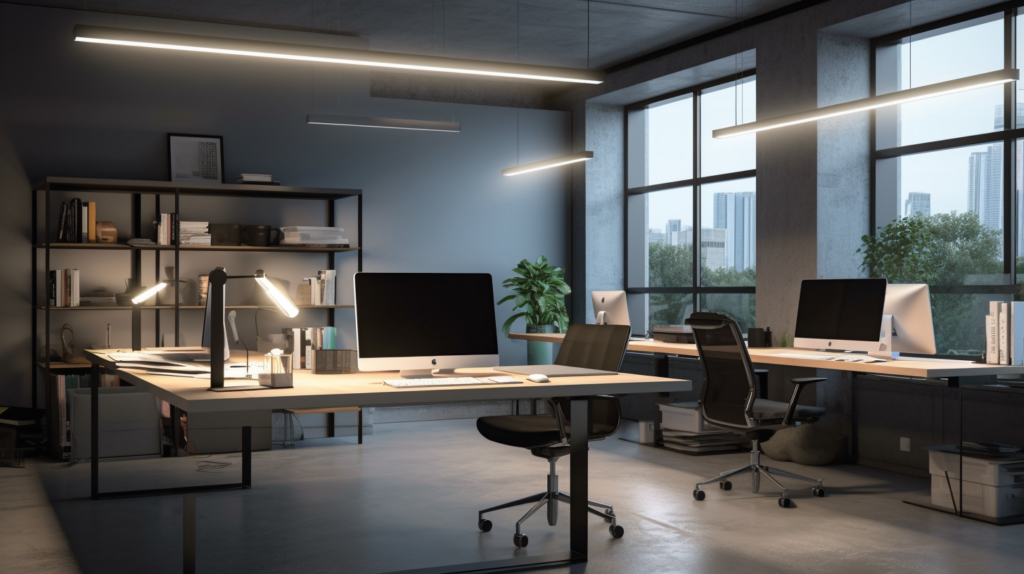
Task lighting provides additional illumination over a smaller work area, providing the additional illumination required for smaller or lower contrast tasks whilst preventing ambient light from being too high for other tasks. It can also have a psychological impact, aiding in focusing on the task at hand, especially when the task lighting has a cooler color than the ambient lighting used.
The easiest and most effective way to implement task lighting into an office environment is simply through the use of desk lamps. These allow employees to easily turn them on and off as needed throughout the working day and they are focused enough that their use has minimal to no impact on other employees.
Ambient Lighting For Offices
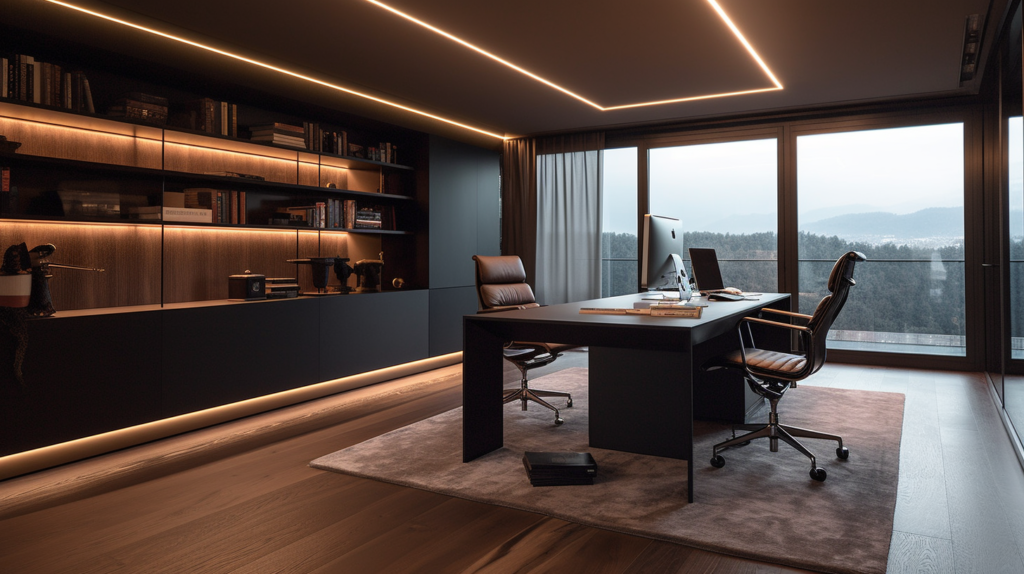
It’s important to get your ambient lighting right as it has a major impact on the overall comfort and atmosphere of your workplace. Ambient lighting will need to be powerful enough that employees can comfortably see their environment, but not so bright as to cause excessive computer screen contrast.
Given that almost all office work now has a substantial digital element, staying within the recommended range of 200 to 500 lux is the safest option here. The task lighting will be able to provide any additional illumination required for specific tasks.
Spreading your ambient lighting over multiple less-powerful lights is generally recommended as this reduces glare and can make it easier to achieve more even lighting coverage. An alternate option for less glare is to use a
Choosing the Right Lighting Fixtures
When selecting office lighting fixtures, it’s important to consider what tasks your employees will be performing throughout their workday and how your lighting solution will affect this. The strength and quantity of ambient lighting should be selected so that it is bright enough but not excessively bright, consistently falling within the recommended lux levels. There should be sufficient task lighting options available to meet any additional illumination needs employees may have for specific tasks.
We offer some great modern linear office lighting that is both versatile and cost effective.
As mentioned before, don’t forget about the color temperature, which can impact the mood of employees and, in the case of cooler lighting, help to promote focus. The positioning of the light fittings is also important, as you will need to ensure that they are positioned in such a way that the room is evenly lit, without creating issues with shadow or glare.
Energy Efficiency

With the increased focus on sustainability, you may also wish to consider how environmentally friendly your lighting choices are. It is now easier than ever to access reasonably priced energy-efficient lighting solutions such as LEDs. These options help your business reduce its environmental impact by using less power and often lasting longer, therefore needing fewer replacements. This can also reduce energy bills and maintenance costs, benefitting your bottom line.
Maintenance and Cost Considerations
Whichever lighting option you choose, you will need to pay for it and undertake any necessary maintenance to keep it in good working order. If cost is a strong factor, it is definitely worth prioritizing comfortable and appropriate lighting over the look of the fixtures, particularly in areas that are not customer-facing. You should also have an understanding of how difficult it will be to replace bulbs and maintain the fixtures and how often replacements are likely to be required before purchasing. This is why a products warranty is important when shopping around. For example, all of our commercial light fixtures come with a 5 year warranty.
If part of your lighting solution involves natural light through windows or skylights, your maintenance should also include ensuring that these are kept clean so that sufficient light can continue to get in.
Lighting Standards for Specialized Office Areas
There is no requirement to have the same lighting throughout the entire workplace and it may not actually be wise to do so. Different parts of the building serve different purposes and as such it is often worth considering how best to illuminate them on an individual basis.
Conference Rooms and Meeting Spaces
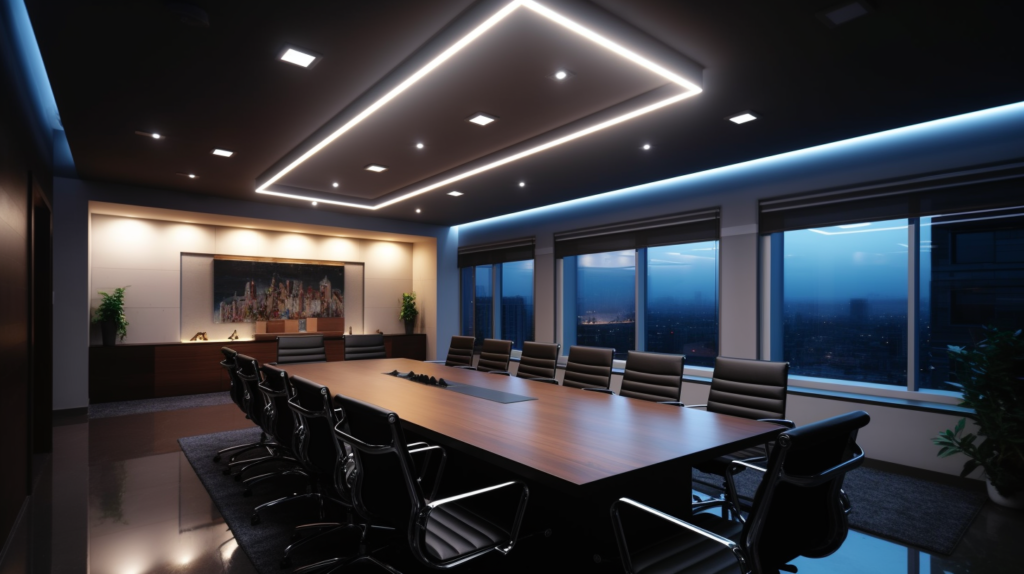
Conference rooms and meeting spaces often have less focus on screens than the general office environment, meaning that there usually isn’t a need to keep the illumination level down out of concerns for screen contrast. If those attending are likely to be making notes or reading from handouts, this is a lower contrast activity and as such would warrant higher lux lighting.
There is no hard and fast rule for the color temperature of the lighting in such circumstances, but consideration should be given so that it complements the mood of the meeting. If your conference room is multi-functional, I would suggest getting dimmable fixtures in a neutral color temperature (4000-5000 kelvin).
Breakrooms and Employee Lounges
As these are environments intended to allow employees to rest and relax, the lighting should reflect this. The focus should primarily be on comfort as practical concerns involving the use of computer monitors and other work-related tasks are at a minimum here. Warmer lighting is ideal here for its ability to help with relaxation.
Reception Areas and Customer-Facing Zones
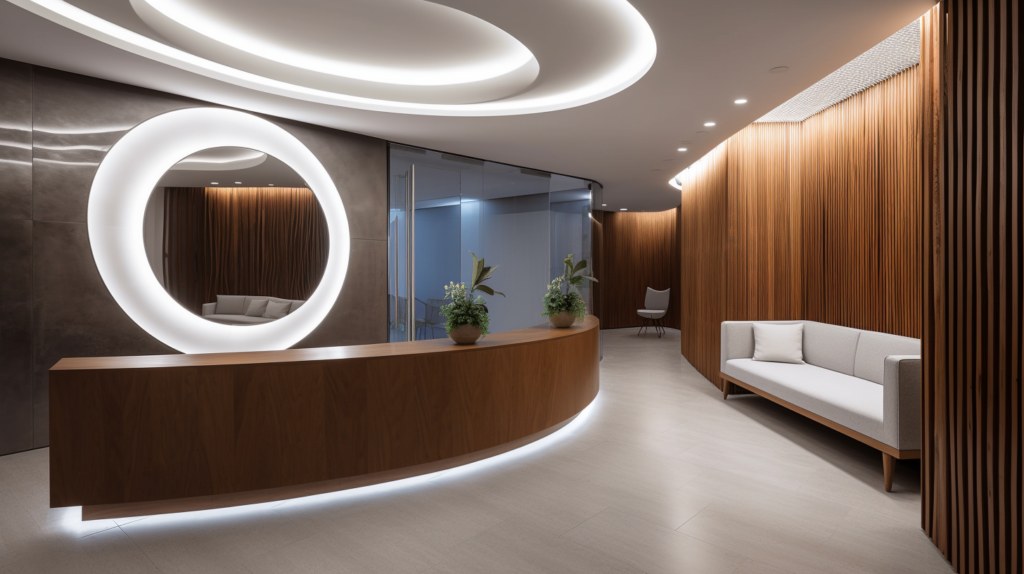
Again, these are areas where it can be beneficial to control the color temperature of the lighting in order to promote a certain mood.
These are also areas where you will typically want to skew towards warmer lighting in order to promote a feeling of relaxation, which can help interactions with customers go smoothly and make any waiting periods more pleasant.
Of course, it is still important to remember that reception staff typically spend a significant amount of time consulting information on a computer monitor, and care should be taken that the chosen lighting solution doesn’t make it difficult or uncomfortable for them to do so.
Frequently Asked Questions
How can I save money on office lighting?
To save money on office lighting you want to focus on the efficiency of your fixtures as they will pay themselves back in time with savings on your electricity bill. Generally DLC listed fixtures are eligible for utility rebates that really add up over time.
Another way to save money is having occupancy motion sensors and daylight sensors for your office lighting to ensure they power off or dim down when they’re not needed.
How much does office lighting cost?
Office lighting ranges a lot in price depending on the type of fixture and the features they have. I would suggest investing in LED fixtures at the very minimum as they will save you money over time. When comparing lighting pricing you want to make sure you keep an eye on warranty information, lumen output, and features offered.
One the cheaper end, 4×2 LED panel lights start are around $70-80. On the other hand, certain brands sell architectural recessed lights for as high as $800 or more.
What are workplace lighting requirements?
Workplace lighting requirements refer to the standards set by regulatory bodies like Occupational Safety and Health Administration (OSHA) to ensure proper lighting in offices and other workspaces. These requirements are aimed at creating a safe and healthy working environment.
How does proper lighting affect productivity?
Proper lighting plays a crucial role in enhancing productivity in the workplace. Bright light and a well-designed lighting system can improve working conditions, reduce eye strain, and promote a sense of well-being among employees.
What are some common lighting regulations for offices?
Some common lighting regulations for offices include adhering to OSHA & IES light standards, ensuring proper lighting levels, using energy-efficient lighting, regularly inspecting lighting fixtures, and providing adequate lighting for different tasks.
Why is proper lighting important for occupational health and safety?
Proper lighting is particularly important for occupational health and safety as it helps prevent accidents, reduces the risk of eye strain and fatigue, and ensures employees can clearly see their tasks and surroundings. It contributes to a safe and productive workplace.
I have been the project manager for Modern.Place since early 2016, spending three of those years working overseas on the manufacturing & procurement side of the LED lighting industry. Constantly learning and passing on knowledge to others while excited for what the lighting industry will involve into next.

